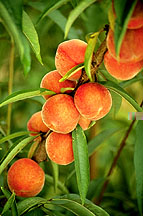Read the
magazine
story to find out more.
|

ARS has found environmentally friendly
alternatives for controlling peach pests. Click the image for more
information about it.
|
|

|
Environmentally-Friendly Controls for Peach Tree
Pests
By Sharon
Durham
March 7, 2008 Peach growers combat several insects
that harm their crop, usually using chemical pesticides to do so. Agricultural
Research Service (ARS) scientists in the
Southeastern
Fruit and Tree Nut Research Laboratory in Byron, Ga., are seeking
environmentally friendly alternatives.
ARS entomologists
David
Shapiro-Ilan and
Ted
Cottrell, along with colleagues at the University of Florida and the
University of Georgia, are evaluating two
tiny, soil-dwelling nematodes as possible biological controls. They were used
to thwart damage caused by the plum curculio weevil (Conotrachelus
nenuphar), and two clear-winged moths, the peachtree borer (Synanthedon
exitiosa), and the lesser peachtree borer (S. pictipes).
Shapiro-Ilan and Cottrell used the Steinernema riobrave nematode to
defend against plum curculio larvae—producing a suppression rate of 78 to
100 percent.
For the peachtree borer, the researchers used another beneficial
nematode, Steinernema carpocapsae. They found that a single field
application of S. carpocapsae provided 88 percent suppression when
applied to mature peachtree borer infestations in springtime. In a recent field
trial, three applications of S. carpocapsae during the peachtree borer's
fall egg-laying season completely suppressed all damage.
The scientists knew from lab studies that another peach pest, the lesser
peachtree borer, is also highly susceptible to S. carpocapsae. But the
researchers also realized that controlling the lesser peachtree borer would be
more difficult because they attack trees aboveground—where the nematodes
dry out and are less effective.
To deal with this problem, the researchers applied S. carpocapsae
nematodes to tree wounds and then covered the wounds with moisture-holding
bandages. In the first trial, 100 percent lesser peachtree borer mortality was
attained in five days.
Read
more about this research in the March 2008 issue of Agricultural
Research magazine.
ARS is the U.S. Department of
Agriculture's chief scientific research agency.